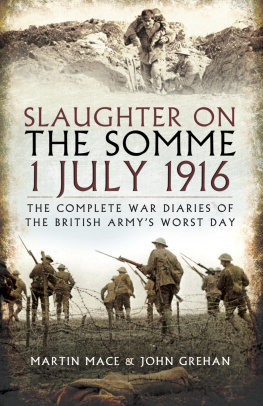First published in Great Britain in 2014 by
PEN & SWORD MILITARY
An imprint of
Pen & Sword Books Ltd
47 Church Street
Barnsley
South Yorkshire
S70 2AS
Copyright John Grehan and Martin Mace, 2014
ISBN 978-1-78159-344-8
eISBN 9781473839618
The right of John Grehan and Martin Mace to be identified as the authors of this work has been asserted by them in accordance with the Copyright, Designs and Patents Act 1988.
A CIP catalogue record for this book is available from the British Library.
All rights reserved. No part of this book may be reproduced or transmitted in any form or by any means, electronic or mechanical including photocopying, recording or by any information storage and retrieval system, without permission from the Publisher in writing.
Typeset by Concept, Huddersfield, West Yorkshire HD4 5JL.
Printed and bound in England by CPI Group (UK) Ltd, Croydon CR0 4YY.
Pen & Sword Books Ltd incorporates the imprints of Pen & Sword Archaeology,
Atlas, Aviation, Battleground, Discovery, Family History, History, Maritime,
Military, Naval, Politics, Railways, Select, Social History, Transport, True Crime,
and Claymore Press, Frontline Books, Leo Cooper, Praetorian Press,
Remember When, Seaforth Publishing and Wharncliffe.
For a complete list of Pen & Sword titles please contact
PEN & SWORD BOOKS LIMITED
47 Church Street, Barnsley, South Yorkshire, S70 2AS, England
E-mail: enquiries@pen-and-sword.co.uk
Website: www.pen-and-sword.co.uk
Contents
List of Plates
Introduction
The operation against the Turkish Ottoman Empire which began in 1915 was originally intended to be nothing more than a demonstration to help relieve pressure on Britain and Frances ally, Russia. Tsar Nicholas IIs forces were fighting on two fronts and barely able to hold back the Germans and Austrians, leaving them severely weakened in the Caucasus. Britains military and political leaders, Churchill, Kitchener, Fisher, Carden and Lloyd George, turned that limited objective into a major offensive which absorbed half-a-million men and vast amounts of military and naval resources. Almost half of those men became casualties.
At first the campaign against Turkey was purely naval. It was led by Vice-Admiral Sir Sackville Hamilton Carden who at the time was in command of the Royal Navys Mediterranean Squadron. As early as November 1914, as soon as hostilities between Russia and Turkey had started, Carden with a combined Anglo-French squadron had tried to force the Dardanelles Strait, a 30-mile long strait in north-western Turkey which, linking the Sea of Marmara to the Aegean, is only between 0.75 to 3.7 miles wide.
In his first despatch, Carden reported back that the Turkish batteries opened fire as soon as the Allied ships made their run. The Allied warships counter-fire was highly effective and it was believed that some 600 casualties had been inflicted on the Turkish gunners. When, on 19 February 1915, Carden conducted a second run past the Turkish batteries and deliberately bombarded the Turkish positions from the outset, the Turkish gunners remained under cover and did not venture out to man their guns until the afternoon.
Operations continued in February and March in which landing parties captured some of the Turkish forts. Yet it was not the land defences that ultimately proved decisive but the mine fields which had been sown across the Strait.
On 18 March, in another attempt on the Dardanelles, three battleships were sunk by mines and another damaged, and Rear Admiral John de Robeck, who had taken over from Carden just three days before, called off the attack. These were the worst losses suffered by the Royal Navy in battle since Trafalgar.
At this point, Britain and France could have scaled down their operations in this theatre. They had made the demonstration that Russia had pleaded for and if they kept a number of warships in the area, the Turks would have been compelled to maintain substantial forces on the Gallipoli Peninsula to ensure its safety. However, General Sir Ian Hamilton, who had been given command of the Allied Mediterranean Expeditionary Force, was present with the Royal Navy on 18 March and in his first despatch he wrote: I witnessed these stupendous events, and thereupon cabled your Lordship my reluctant deduction that the co-operation of the whole of the force under my command would be required to enable the Fleet effectively to force the Dardanelles.
What Hamilton made clear was that nothing but a thorough and systematic scheme for flinging the whole of the troops under my command very rapidly ashore could be expected to meet with success; whereas, on the other hand, a tentative or piecemeal programme was bound to lead to disaster. That, though, is exactly what happened.
The initial Allied landings took place on 25 April 1915, and in the intervening weeks the Turks had worked hard on their defences and reinforced their troops. Generalleutnant Otto Liman von Sanders, an adviser and military commander for the Ottoman Empire during the First World War, later noted: The British allowed us four good weeks of respite for all this work before their great disembarkation... This respite just sufficed for the most indispensable measures to be taken. Roads were constructed, small boats assembled to carry troops and equipment across the narrows, beaches were wired, makeshift mines constructed from torpedo-heads and trenches and gun emplacements were dug along the beaches.
Despite the obvious fact that a very large force indeed would be required to seize Gallipoli and achieve the new final objective of capturing Constantinople, only around 80,000 men were available to Hamilton. A month after the initial landings, little progress had been made by the Allied troops. The expeditionary force was still trapped with its back to the sea, with the Turks holding the high ground that prevented the British and Commonwealth troops from breaking inland.
The difficulties that the operation had encountered were spelt out by Hamilton in his despatch of 20 May 1915: The landing of an army upon the theatre of operations I have described a theatre strongly garrisoned throughout, and prepared for any such attempt involved difficulties for which no precedent was forthcoming in military history except possibly in the sinister legends of Xerxes. The beaches were either so well defended by works and guns, or else so restricted by nature that it did not seem possible, even by two or three simultaneous landings, to pass the troops ashore quickly enough to enable them to maintain themselves against the rapid concentration and counter-attack which the enemy was bound in such case to attempt. It became necessary, therefore, not only to land simultaneously at as many points as possible, but to threaten to land at other points as well.
By this time these factors were only too well known. Whilst Hamilton had managed to land his forces, repeated attempts to break out of the beachheads had failed, as had Turkish counter-attacks aimed at driving the Allies from their slender toe-hold. Casualties on both sides were shocking, and conditions for the troops, continuously exposed in the heat of summer, scarcely bearable.
This is vividly described by Hamilton in his despatch of 26 August: The country is broken, mountainous, arid and void of supplies; the water found in the areas occupied by our forces is quite inadequate for their needs; the only practicable beaches are small, cramped breaks in impracticable lines of cliffs; with the wind in certain quarters no sort of landing is possible; the wastage, by bombardment and wreckage, of lighters and small craft has led to crisis after crisis in our carrying capacity, whilst over every single beach plays fitfully throughout each day a devastating shell fire at medium ranges. Hamilton made urgent calls for reinforcements.


















